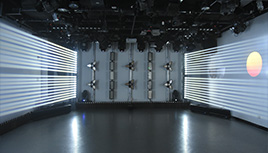The Impact of Stage Lighting on Audience Experience
2025-02-07 Post By: Longmangroup
Stage lighting plays a crucial role in shaping the emotional and visual experience of an audience. While it is often seen as a technical element, the lighting design is integral to creating the atmosphere, guiding attention, and enhancing storytelling during live performances. As stage lighting continues to evolve with the use of LED stage lights, its impact on audience experience becomes even more profound.Setting the Mood
The most immediate effect of stage lighting is its ability to influence the mood. A well-placed light can transform a scene from dramatic to serene, happy to somber, or energetic to mysterious. The color temperature of LED stage lights is particularly important in this aspect—warmer hues like amber and red evoke warmth and comfort, while cooler blues and greens can induce a sense of calm or alienation. The manipulation of light intensity and color changes can subtly alter the emotional tone, influencing how the audience connects with the performance.
Focusing Attention
Lighting also serves a functional purpose: it directs the audience's attention. Spotlighting a performer or a specific area of the stage isolates the subject, guiding the audience’s focus to key moments. For example, LED stage lights can highlight the lead actor while dimming the background, allowing for seamless transitions between different scenes. This dynamic interaction between light and performers heightens the emotional intensity of the moment.
Immersing the Audience
With the advent of more interactive and immersive experiences, stage lighting is evolving to engage the audience in unique ways. Integration with technology such as video projections and LED systems allows for real-time adjustments based on the action happening on stage. This creates a 360-degree visual experience that can wrap around the audience, drawing them deeper into the performance. LED stage lights are particularly suited for such applications, providing flexibility in color, movement, and intensity, thereby enhancing the audience's immersion.
Creating Visual Impact
Finally, stage lighting amplifies the overall visual spectacle. Complex lighting setups can complement special effects like pyrotechnics, fog machines, or lasers. When synced with sound and visual effects, LED stage lights can create a fully immersive, multi-sensory experience. This synergy between lighting, sound, and visual effects leaves a lasting impression on the audience, making the performance unforgettable.
Take some types of stage lights for example, here's a breakdown of how different types of stage lights impact the audience's experience during a live performance:
1. Moving Head Light
- Impact on Audience Experience: Moving head lights bring dynamic, fluid movement to the stage, helping to focus the audience’s attention on key moments or performers. Their ability to change direction, color, and intensity makes them a powerful tool for building excitement and tension during a performance.
- Example: During a concert, moving head lights can follow the lead singer across the stage, creating a sense of action and drawing the audience’s focus to them. The changing colors and intensity can match the music's energy, intensifying the audience's emotional connection to the performance.
- Impact on Audience Experience: PAR lights are great for creating broad, even washes of light that help set the atmosphere. These lights are commonly used to illuminate the stage and performers, providing consistent lighting for large areas.
- Example: For a theater production, PAR lights can be used to wash the stage in warm, soft lighting, establishing a cozy or romantic mood. The uniform light creates a comfortable environment where the audience feels invited into the performance.
- Impact on Audience Experience: Wash lights flood the stage with soft light, often used to create an ambient mood or to set the tone for specific scenes. By adjusting their intensity and color, wash lights enhance emotional atmosphere without overpowering the performance.
- Example: In an intimate scene, wash lights in warm hues can create a sense of nostalgia or warmth, gently wrapping the audience in a comforting embrace. In contrast, cooler wash lights can evoke a more subdued, contemplative feeling.
- Impact on Audience Experience: Pixel background lights are used for stunning visual effects, adding dimension and texture to the backdrop of a performance. By integrating with video projections or motion graphics, they contribute to the immersive quality of the production.
- Example: During a concert, pixel background lights can create vibrant, interactive backdrops that change with the music, adding an extra layer of excitement and visual stimulation that surrounds the audience.
- Impact on Audience Experience: Laser lights create sharp, intense beams that add drama and focus to specific moments. Their precision and ability to cut through smoke or haze create a futuristic or dramatic effect that captivates the audience.
- Example: In a live show, laser lights can create striking visuals that interact with music beats, forming intricate patterns in the air. The rapid, sharp beams of light add to the sense of intensity, making climactic moments feel more electrifying.
- Impact on Audience Experience: Gobo lights project patterns or textures onto the stage, adding depth and dimension to the visual experience. These lights can be used to create thematic settings or emphasize particular objects or performers.
- Example: In a performance with a forest theme, gobo lights can project leaf or tree patterns onto the floor or backdrop, enhancing the feeling of being in a forest and reinforcing the scene's narrative.
- Impact on Audience Experience: Hybrid lights that combine beam, wash, and spot effects offer ultimate flexibility and control. This allows designers to quickly switch between effects, giving them the ability to adapt lighting to fast-paced changes in the performance.
- Example: During a dynamic concert, hybrid lights can create sharp beams that highlight individual performers, while the wash effect can bathe the whole stage in color. The flexibility of switching between effects helps maintain energy throughout the performance.
- Impact on Audience Experience: Profile and ellipsoidal lights are used for precision lighting, such as creating sharp, focused spots or accentuating specific details on stage. These lights are excellent for enhancing the visibility of a particular performer or scene.
- Example: During a dramatic monologue, profile lights can focus entirely on the actor, isolating them from the rest of the stage and drawing the audience’s attention solely to their performance, intensifying the emotional depth.
- Impact on Audience Experience: Strobe lights create rapid bursts of light that can induce a sense of urgency or excitement. They are commonly used for high-energy moments in performances, like dance shows or concerts.
- Example: In a fast-paced concert or theatrical scene, strobe lights can synchronize with the music or action on stage, amplifying the intensity of key moments and energizing the audience.
Each type of stage light plays a unique role in shaping the audience's experience during a live performance. From the dynamic movement of moving head lights to the ambient warmth of wash lights, every light has the potential to enhance emotions, focus attention, and immerse the audience in the performance. By understanding the impact of these various lights, designers can craft truly memorable experiences that leave a lasting impression on the audience.














